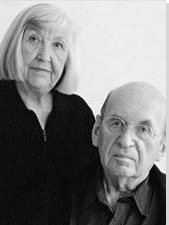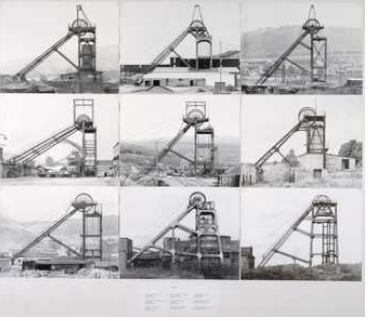Who are they?
Bernd (1931–2007) and Hilla Becher (1934–2015) are considered the most influential German photographers of the post-war period. Over the past 50 years, the couple and artist duo captured the aesthetic of disappearing industrial facilities, often making the overlooked structures visible to viewers for the first time. Their strict adherence to particular formal principles and their typological approach gave rise to the idea of photography as conceptual art. The Bechers taught at the Kunstakademie Dusseldorf and shaped the work of an entire generation of photographers, including Andreas Gursky, Thomas Ruff, Candida Höfer and Thomas Struth. Sprüth Magers represents the artist couple’s Estate.
Hilla Becher was a German artist born in 1931 in Siegen, Germany. She was one half of a photography duo with her husband Bernd Becher. For forty years, they photographed disappearing industrial architecture around Europe and North America.
They won the Erasmus Prize in 2002 and Hasselblad Award in 2004 for their work and roles as photography professors at the art academy Kunstakademie Düsseldorf.

What did they photograph?
Industrial structures including water towers, coal bunkers, gas tanks and factories. Their work had a documentary style as their images were always taken in black and white. Their photographs never included people.
They exhibited their work in sets or typologies, grouping of several photographs of the same type of structure. The are well known for presenting their images in grid formations.


This sequence of photographs, showing pitheads from British mining and quarrying sites, were taken from 1965 to 1974 and is representative of the way the Bechers chose to display their work through their career, arranging images in groups according to type. Pitheads, known as such in the United Kingdom and as winding towers elsewhere, were positioned at the top of coal shafts and served as mechanisms for hoisting gear into and out of mines. These nine images, arranged in rows of three, all show the pithead from the same distance and perspective, centering the structure in the frame and tightly cropping the surrounding buildings. In each case, the horizon is low and the backdrop cloudy; the pitheads themselves rise up as triangles, with circular rigs positioned at top of the structure, where a vertical base intersects with a metal diagonal leading into the mine itself.
my response to typologies:


Here is my typologies photoshoot, I decided to take photos of car wheels as they’re all very similar however they all have different features. I changed them into black and white to help them be more unison.
